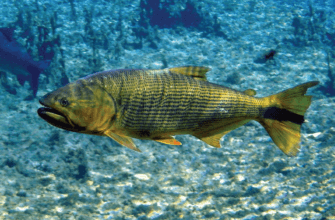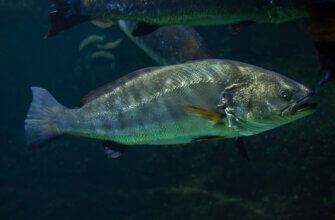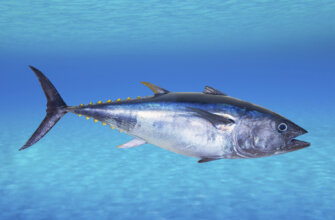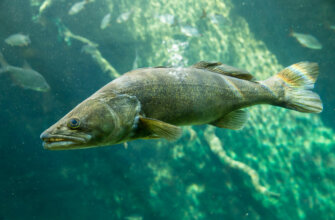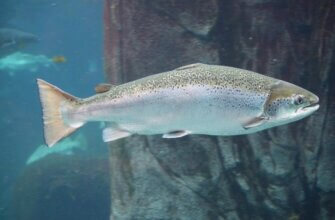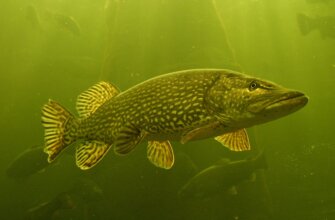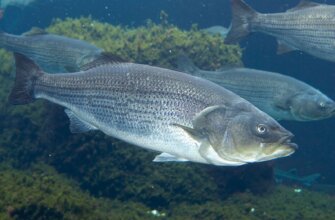The Arapaima (Pirarucu) is a large freshwater fish found in the Amazon Basin in South America, particularly in Brazil, Peru, and Colombia. Arapaima can grow up to 9 feet in length and weigh over 400 pounds. They are a popular game fish and are also important to indigenous communities for their meat and valuable scales.
Arapaima are primarily found in slow-moving rivers, flooded forests, and lakes, where they feed on fish, crustaceans, and small mammals. They have a unique adaptation that allows them to breathe air, which enables them to survive in oxygen-deprived environments. Arapaima can be kept in captivity and have been introduced into aquaculture systems.
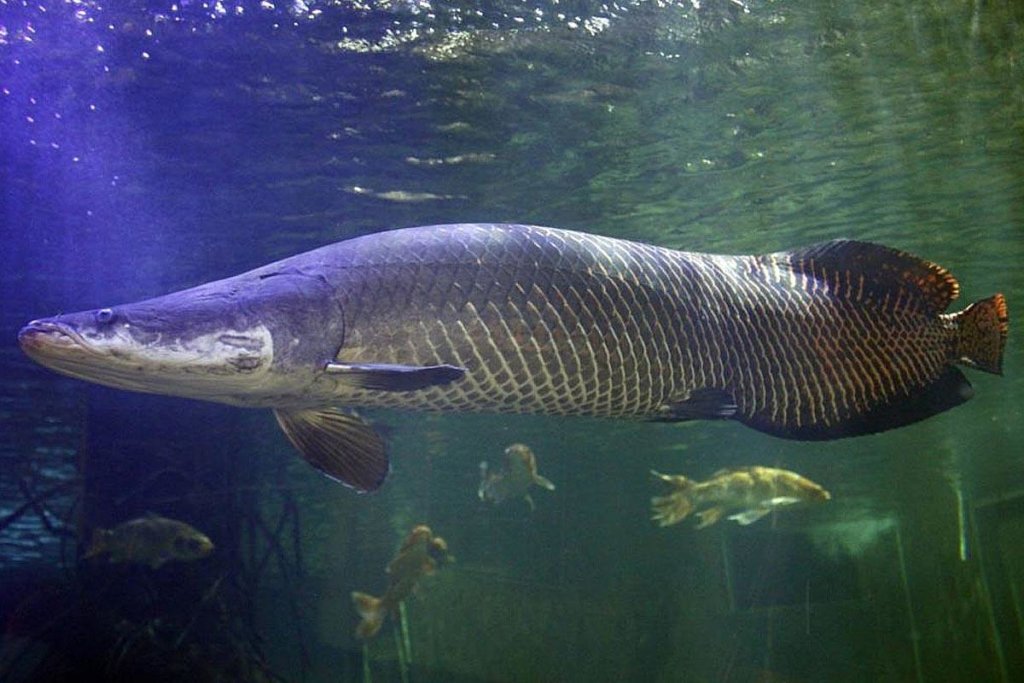
Due to their large size and desirable meat, Arapaima have become overfished in some areas, leading to population declines. However, sustainable farming practices have been developed to breed and raise Arapaima for food, while also protecting wild populations.
Arapaima have cultural importance in the Amazon region, where they are revered as a symbol of power and strength. They have also been used in traditional medicine to treat a variety of ailments.
Due to overfishing and habitat destruction, the Arapaima population has declined significantly in recent years, and they are now listed as vulnerable by the International Union for Conservation of Nature (IUCN). Conservation efforts are being made to protect the Arapaima’s habitat and regulate fishing to ensure their survival.
Species
There are several species of Arapaima, but the most commonly recognized ones are:
- Arapaima gigas: This is the largest and most well-known species of Arapaima. It is also known as the pirarucu, and is found in the Amazon Basin of South America.
- Arapaima leptosoma: This is a smaller species of Arapaima, reaching up to about 4 feet in length. It is found in the Rio Solimões and Rio Madeira in Brazil.
- Arapaima arapaima: This is a relatively new species of Arapaima that was discovered in 2016. It is found in the Purus and Madeira river basins in Brazil, and can reach up to 6 feet in length.
- Arapaima mapae: This is a species of Arapaima that is found in the upper Amazon Basin in Colombia, Peru, and Brazil. It is smaller than Arapaima gigas, reaching up to about 5 feet in length.
All species of Arapaima are threatened due to overfishing and habitat destruction, and are listed as vulnerable or endangered by the International Union for Conservation of Nature (IUCN).
Appearance
Arapaima, also known as pirarucu, is a freshwater fish that has a distinctive and striking appearance. It has a long, cylindrical body that is covered in large, bony scales, which can be up to 10 centimeters in diameter. The fish has a large, broad head with a wide, upward-facing mouth that is adapted for catching prey at the surface of the water. Arapaima’s body is dark green or grayish-brown on the back, and lighter on the belly. It has a distinctive red marking around the eyes, which makes it easily recognizable.
Size
Arapaima are one of the largest freshwater fish in the world, and can grow up to 9 feet in length and weigh over 400 pounds. However, the average size of Arapaima is typically around 6 feet in length and 200-300 pounds in weight. The size of an Arapaima can vary depending on its age, sex, and environmental conditions. Arapaima can live for over 20 years in the wild, and during that time, they can continue to grow and reach impressive sizes.
Biggest Arapaima
The exact size of the largest arapaima ever caught is not known, as many of the biggest arapaima caught have been released back into the wild. However, according to the International Game Fish Association (IGFA), the current world record for arapaima is a 440-pound (199.58 kg) fish caught in Brazil in 2019 by angler Jakub Vagner. This arapaima was caught on a fly rod, and took over an hour to land.
Diet
The Arapaima is a carnivorous fish and primarily feeds on other fish, crustaceans, and small mammals. Its diet consists of a wide variety of prey, including smaller fish like tetras, catfish, and piranhas, as well as crustaceans like crabs and shrimp. Arapaima have a unique adaptation that allows them to swallow air, which they use to supplement their oxygen supply when they are in poorly oxygenated water. This ability also allows them to feed on prey that are found near the water’s surface, such as birds and small mammals. In captivity, Arapaima can be fed a diet of fish pellets, but a varied diet is recommended to ensure they receive all necessary nutrients.
Behavior
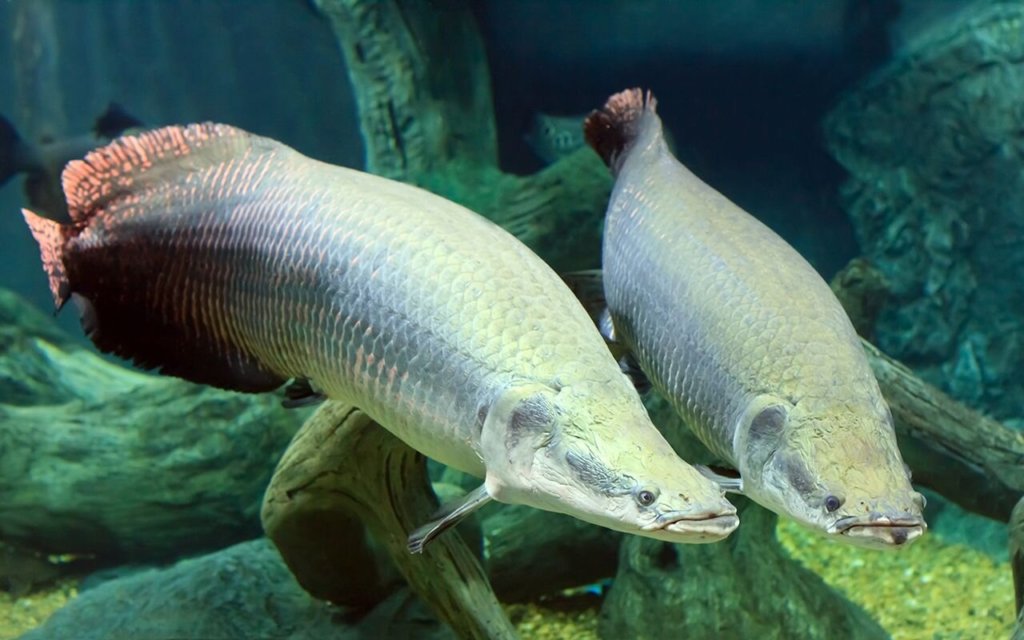
Arapaima, also known as pirarucu, is a large freshwater fish that has a number of interesting behaviors. Here are some of the most notable behaviors of Arapaima:
- Surface breathing: Arapaima is an air-breathing fish, and it has to come to the surface to breathe. It will often make a loud gasping noise when it breathes, which can be heard from a distance.
- Social behavior: Arapaima is a social fish and can often be found swimming in schools. They are also known to exhibit parental care, with the parents guarding the eggs and the young after hatching.
- Nocturnal feeding: Arapaima is mostly active at night, and it feeds on a variety of prey, including fish, crustaceans, and insects.
- Territorial behavior: Arapaima is territorial and will defend its space against other fish, especially during the breeding season.
- Jumping behavior: Arapaima is also known for its jumping behavior, where it jumps out of the water and makes a loud splash. It is believed that this behavior is a way of communicating with other fish or marking its territory.
Overall, Arapaima is a fascinating fish with a range of interesting behaviors. Its air-breathing, social, and territorial behaviors make it an important species in the Amazon Basin ecosystem.
Spawning
The Arapaima is a species of South American freshwater fish known for their large size and unique characteristics. One of the most fascinating aspects of Arapaima is their spawning behavior, which is quite different than that of most other fish species.
Arapaima typically spawn during the rainy season, which usually falls between November and February in their native range. They are known to migrate upstream to shallow waters in search of suitable nesting grounds. Unlike other fish that typically scatter their eggs, Arapaima lay their eggs in a large communal nest. The nesting site can be as large as twenty feet wide and up to three feet deep.
Males and females collaborate in the construction of the nest, consistently diving deep into the water to retrieve plant materials such as branches, leaves, and stems. They then bring them to the nesting site, where the nest is built up layer by layer. The nest is protected by a group of males, who work together to keep predators such as other fish, birds, and even caimans away.
Once the nest is completed, the female Arapaima lays her eggs, which can number anywhere between 1000 to 5000 per female depending on her size. Males then fertilize the eggs externally before diligence to protect and oxygenate them by gently fanning them with their fins. The eggs will hatch within a week, upon which the young Arapaima will remain in the nest together with the male that continues guarding the newly hatched fry for up to several weeks until they swim free from the nest.
In conclusion, Arapaima spawning is a unique phenomenon demonstrating the sophistication of the species’ reproductive behavior. Their communal nest construction, collaboration between sexes, and protection tactics of their young all suggest tremendous adaptations that have helped these fish thrive for over 300 million years, earning them the moniker “dinosaur fish.”
Fishing
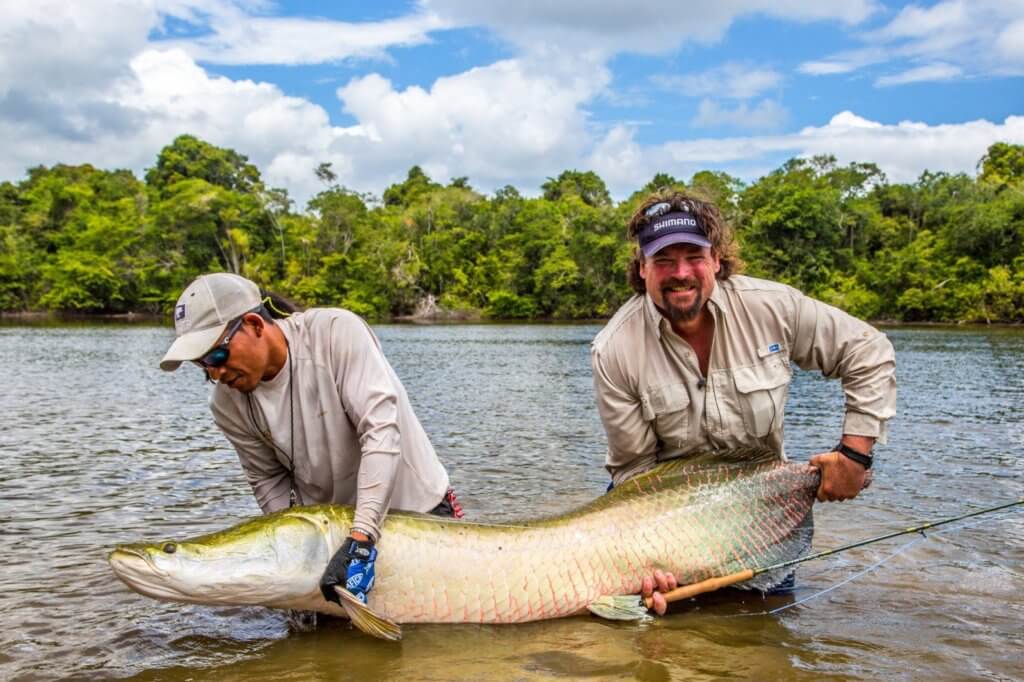
Due to their large size and popularity among anglers, arapaima are often targeted using a variety of fishing methods. Here are some of the most common techniques used to catch arapaima:
- Bait fishing: This involves using live or dead bait, such as fish or shrimp, to lure arapaima to the fishing line. The bait is typically placed on a hook and cast into the water, where it is left to drift or sink to the bottom. Once an arapaima takes the bait, the angler must quickly set the hook and start reeling in the fish.
- Fly fishing: This method involves using artificial flies that imitate the natural prey of arapaima, such as insects or small fish. The angler casts the fly using a specialized rod and line, and then strips or retrieves the fly back to the boat or shore. Arapaima can be caught using both surface and subsurface flies.
- Lure fishing: This method involves using artificial lures, such as spoons, spinners, or plugs, to attract arapaima. The lures are typically cast out and retrieved at a steady pace, mimicking the movement of prey. Anglers can experiment with different types of lures and retrieve speeds to find what works best for the specific arapaima population they are targeting.
- Bowfishing: This method involves using a specialized bow and arrow to shoot arapaima while they are swimming near the surface. This technique requires skill and precision, as arapaima are quick and agile swimmers.
It is important to note that arapaima are a protected species in many areas due to overfishing and habitat loss. Before attempting to catch arapaima, anglers should check local regulations and obtain any necessary permits or licenses. Additionally, catch-and-release practices are recommended to help preserve arapaima populations for future generations.
Lures
To catch Arapaima, you need to use lures that are designed to handle their size and strength. Here are some types of lures that can be effective for Arapaima fishing:
- Large Topwater Lures: These lures are designed to create a commotion on the surface of the water, which can trigger a predatory response from Arapaima. Examples of topwater lures for Arapaima include the Heddon Zara Spook, the River2Sea Whopper Plopper, and the Savage Gear 3D Topwater Bat.
- Large Swimbait Lures: Swimbait lures are designed to mimic the swimming action of baitfish, which can attract the attention of predatory fish like Arapaima. Examples of swimbaits for Arapaima include the Savage Gear 3D Shine Glide, the Strike King Shadalicious, and the Huddleston Deluxe Swimbait.
- Large Spinnerbait Lures: These lures feature a spinning blade that creates vibration and flash in the water, which can attract the attention of Arapaima. Examples of spinnerbaits for Arapaima include the Booyah Counter Strike Spinnerbait, the Strike King Burner Spinnerbait, and the Megabass V-Flat Power Bomb Spinnerbait.
- Large Crankbait Lures: Crankbaits are designed to dive to a certain depth and swim in a particular way, which can attract the attention of Arapaima. Examples of crankbaits for Arapaima include the Spro BBZ-1 Swimbait, the Rapala X-Rap Magnum, and the Megabass Deep-X 300.
It’s important to choose lures that are big enough to handle the size and strength of Arapaima. Make sure that you use a heavy duty fishing rod and reel to handle the size and strength of the fish.
Remember, fishing for Arapaima requires specialized gear and techniques, and it’s important to research and follow local regulations and guidelines for Arapaima fishing in the Amazon Basin.
When selecting a lure for arapaima fishing, it’s important to consider the size and color of the lure, as well as the type of retrieve that is most effective for that particular lure. Additionally, anglers should match the size and action of the lure to the size and feeding habits of the arapaima in the area they are fishing. It’s also important to remember that arapaima are a protected species in many areas, so anglers should follow local regulations and practice catch-and-release fishing to help preserve arapaima populations.
Baits
Arapaima is a predatory fish that can be caught using a variety of bait. Here are some options for bait to use when targeting Arapaima:
- Live bait: Live bait is one of the most effective ways to catch Arapaima. Popular live bait options include small fish, such as tilapia, or live shrimp. When using live bait, it’s important to keep the bait as active as possible to attract the Arapaima.
- Lures: Lures can also be effective for catching Arapaima. Topwater lures, such as poppers or surface plugs, can be particularly effective as they mimic the movement of live prey. Soft plastic lures, such as swimbaits or worms, can also be effective when fished slowly and steadily.
- Dead bait: Dead bait can be effective when targeting Arapaima. Whole or cut baitfish, such as mackerel or herring, can be used as dead bait. It’s important to use fresh bait and to change it frequently to maintain its scent.
- Artificial baits: Artificial baits, such as scented dough baits or imitation fish baits, can also be effective when targeting Arapaima. These baits often have a strong scent or flavor to attract the fish.
When choosing bait for Arapaima, it’s important to consider the location and time of day. Arapaima are often found near structure, such as logs or vegetation, so fishing near these areas can be effective. Additionally, Arapaima are most active during early morning or late evening, so fishing during these times can increase your chances of success.
Some examples of fishing baits that are commonly used for Arapaima with their models and specifications:
- Rapala X-Rap Magnum – Model XRMAG20
The Rapala X-Rap Magnum is a popular lure for targeting Arapaima. This lure has a length of 5.5 inches and weighs 1.4 ounces. It is designed to dive up to 20 feet and has a strong rattle to attract the fish. The X-Rap Magnum is available in a variety of colors to match the local baitfish.
- Berkley Gulp! Alive! Shrimp – Model GAJS
The Berkley Gulp! Alive! Shrimp is a soft plastic bait that is effective for targeting Arapaima. This bait is available in a variety of sizes and colors, with a length of 3 inches being a popular size for Arapaima. The Gulp! Alive! Shrimp is infused with a scent and flavor that is attractive to fish and can be fished on a jig head or a Carolina rig.
- Shimano Waxwing – Model WXXT168LCT
The Shimano Waxwing is a topwater lure that can be effective for targeting Arapaima. This lure has a length of 6.5 inches and weighs 1.5 ounces. It is designed to mimic the action of a wounded baitfish and has a long casting distance. The Waxwing is available in a variety of colors to match the local baitfish.
- Live Tilapia
Live tilapia is a popular live bait option for targeting Arapaima. This bait can be fished on a hook or a float rig and is often used near structure, such as logs or vegetation, where Arapaima are known to hang out. When using live bait, it’s important to keep the bait as active as possible to attract the Arapaima.
- Megabass Vision 110 – Model VISION 110
The Megabass Vision 110 is a popular jerkbait for Arapaima fishing. This lure has a length of 4.3 inches and weighs 1/2 ounce. It is designed to mimic the action of a baitfish and has a realistic appearance that can entice Arapaima to bite. The Vision 110 is available in a variety of colors to match the local baitfish.
These are just a few examples of fishing baits that can be used for Arapaima fishing. When choosing a bait, it’s important to consider the location, time of day, and the behavior of the fish. Experimenting with different baits and techniques can help you determine what works best for catching Arapaima in your area.
Rods
Fishing for arapaima, it’s important to use the right rod to handle these large and powerful fish. Here are some key factors to consider when selecting a rod for arapaima fishing:
- Rod length: Arapaima fishing typically requires longer rods to cast larger lures and handle the weight of these large fish. Rods in the range of 7-10 feet are common for arapaima fishing.
- Power and action: Arapaima require a strong and powerful rod with a fast or extra-fast action to handle their size and strength. A heavy power rating is typically required to handle the weight of large lures and fight these fish effectively.
- Rod material: High-quality graphite or composite materials are typically used for arapaima fishing rods to provide the necessary strength and sensitivity to detect bites and fight these fish.
- Line weight: Arapaima fishing often requires heavy line weights, such as 50-80 lb test, to handle the weight and strength of these fish. The rod should be matched to the line weight being used.
- Handle design: Arapaima fishing can be physically demanding, so it’s important to choose a rod with a comfortable and ergonomic handle design that allows for a good grip and reduces fatigue during long periods of fishing.
When selecting a rod for arapaima fishing, it’s important to consider the specific fishing conditions and techniques being used. For example, if fishing in areas with a lot of overhanging vegetation, a shorter rod may be more appropriate. Additionally, anglers should check local regulations to ensure they are using the appropriate gear and following any size or bag limits for arapaima in their area.
A few examples of fishing rods that are suitable for Arapaima fishing, along with their models and specifications:
- Shimano Terez Stand-Up Rod – TZCSTXH2SCBLK
This rod is a great option for targeting Arapaima. It has a length of 5’6″ and a line weight rating of 80-200 lbs. The rod is made from high-modulus carbon fiber, which provides excellent sensitivity and power. It also features Fuji K guides with Alconite inserts, which are designed to reduce friction and improve casting distance.
- Penn Battalion Inshore Casting Rod – BATIN1220C70
The Penn Battalion Inshore Casting Rod is another great option for Arapaima fishing. It has a length of 7′ and a line weight rating of 12-20 lbs. The rod is made from a graphite composite blank, which makes it lightweight and responsive. It also features Fuji aluminum oxide guides, which are durable and corrosion-resistant.
- Daiwa Saltist Demon Blood 72MH
This rod is designed specifically for big game fishing, making it an excellent choice for targeting Arapaima. It has a length of 7’2″ and a line weight rating of 50-100 lbs. The rod is made from Daiwa’s exclusive HVF graphite technology, which provides maximum power and sensitivity. It also features Fuji K guides with Alconite inserts for smooth casting.
- Okuma Cedros CJ-65S Spinning Rod
The Okuma Cedros CJ-65S Spinning Rod is a spinning rod option for Arapaima fishing. It has a length of 6’5″ and a line weight rating of 50-100 lbs. The rod is made from a high-density E-glass blank, which provides excellent durability and power. It also features Fuji K guides with Alconite inserts, which help to reduce friction and improve casting distance.
These are just a few examples of fishing rods that are suitable for Arapaima fishing. When choosing a rod, it’s important to consider the size and weight of the fish you’ll be targeting, as well as the type of fishing you’ll be doing (casting or spinning). Additionally, it’s important to choose a rod that is comfortable to use for long periods of time, as Arapaima fishing can require a lot of patience and stamina.
Dishes
Arapaima is a popular food fish in many regions, and is known for its firm, white flesh and mild flavor. Here are some popular dishes that can be made from arapaima:
- Arapaima steaks: One of the simplest ways to prepare arapaima is to cut the fish into steaks and grill, broil, or pan-fry them. The steaks can be seasoned with salt, pepper, and other spices to taste, and served with a side of vegetables or rice.
- Arapaima ceviche: Ceviche is a popular South American dish that involves marinating raw fish in citrus juice and seasonings. Arapaima is a great fish for ceviche, as its firm flesh holds up well to the acidic marinade. The ceviche can be served with tortilla chips or crackers for dipping.
- Arapaima curry: Arapaima is also commonly used in curries in South America. The fish is typically cut into chunks and simmered in a sauce made from coconut milk, spices, and vegetables, such as onion, garlic, and peppers. The curry is usually served with rice or bread.
- Arapaima chowder: Arapaima can also be used to make a delicious and hearty fish chowder. The fish is usually simmered in a broth made from vegetables, such as onions, carrots, and potatoes, along with cream or milk. The chowder can be seasoned with herbs and spices, such as thyme or bay leaves, to taste.
It’s worth noting that arapaima is a protected species in many areas due to overfishing and habitat loss, so it’s important to ensure that any arapaima used for food is sourced sustainably and in accordance with local regulations.
Conservation Status
To conserve the Arapaima, some measures have been implemented in the Amazon region. For instance, some indigenous communities have been given the responsibility to manage the fishing of Arapaima in their areas. This approach empowers the locals to protect their natural resources by implementing strict fishing regulations, including selective harvesting and seasonal closures. The Arapaima fishermen, for instance, are allowed to fish only a limited number of fish and must release juveniles below certain sizes and females above certain sizes.
Other conservation measures include aquaculture farming of the Arapaima. By cultivating Arapaimas in captivity, it helps to take the pressure off wild populations, while also providing a source of income for the local communities.
Furthermore, some researchers have studied the Arapaima’s behavior, biology, and reproduction, which has helped in the development of fisheries management plans. They have discovered, for example, that Arapaima breeding occurs during the rising waters season when the newly flooded area has become part of the aquatic system. This information is essential for seasonal closures, ensuring the conservation and reproduction of the fish.
In conclusion, the conservation of the Arapaima represents a holistic approach that involves different stakeholders such as the local communities, researchers, and policymakers. The success of these conservation measures lies in cooperation, communication, and continued adaptation to changing circumstances.

